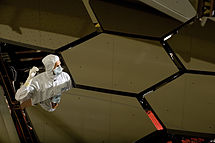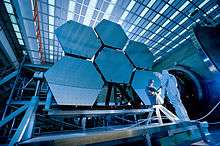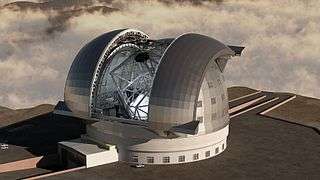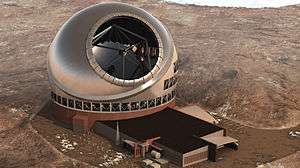Segmented mirror
A segmented mirror is an array of smaller mirrors designed to act as segments of a single large curved mirror. The segments can be either spherical or asymmetric (if they are part of a larger parabolic reflector[1]). They are used as objectives for large reflecting telescopes. To function, all the mirror segments have to be polished to a precise shape and actively aligned by a computer-controlled active optics system using actuators built into the mirror support cell. The concept and necessary technologies were initially developed under the leadership of Dr. Jerry Nelson at the Lawrence Berkeley National Laboratory and University of California during the 1980s, and have since spread worldwide to the point that essentially all future large optical telescopes plan to use segmented mirrors.
Application
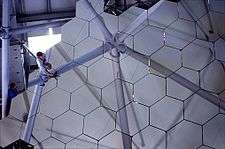
There is a technological limit for primary mirrors made of a single rigid piece of glass. Such non-segmented, or monolithic mirrors can not be constructed larger than about eight meters in diameter. The largest monolithic mirror in use are currently the two primary mirrors of the Large Binocular Telescope, each with a diameter of 8.4 meters. The use of segmented mirrors is therefore a key component for large-aperture telescopes.[2][3] Using a monolithic mirror much larger than 5 meters is prohibitively expensive due to the cost of both the mirror, and the massive structure needed to support it. A mirror beyond that size would also sag slightly under its own weight as the telescope was rotated to different positions,[4][5] changing the precision shape of the surface. Segments are also easier to fabricate, transport, install, and maintain over very large monolithic mirrors.
Segmented mirrors do have the drawback that each segment may require some precise asymmetrical shape, and rely on a complicated computer-controlled mounting system. All of the segments also cause diffraction effects in the final image.
Telescopes using segmented mirrors
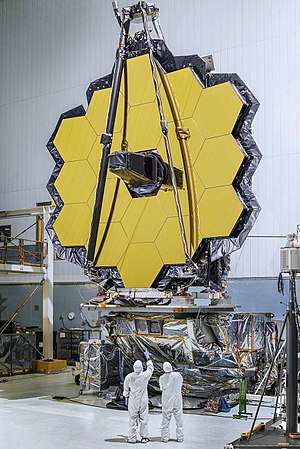
Some of the largest optical telescopes in the world use segmented primary mirrors. These include, but are not limited to the following telescopes:
- Keck Telescopes
- The twin telescopes are the most prominent of the Mauna Kea Observatories at an elevation of 4,145 meters (13,600 ft) near the summit of Mauna Kea in Hawaii, United States. Both telescopes feature 10 m (33 ft) primary mirrors.
- Hobby-Eberly Telescope
- The HET is a 9.2-meter (30-foot) telescope located at the McDonald Observatory, West Texas at an altitude of 2,026 m (6,647 ft). Its primary mirror is constructed from 91 hexagonal segments. The telescope's main mirror is fixed at a 55 degree angle and can rotate around its base. A target is tracked by moving the instruments at the focus of the telescope; this allows access to about 70–81% of the sky at its location and a single target can be tracked for up to two hours.
- The SALT is a 10-meter telescope dedicated on spectroscopy for most of its observing time. It shares similarities with the Hobby-Eberly Telescope and also consists of 91 hexagonal mirror segments, each 1 meter across, resulting in a total hexagonal mirror of 11.1 m by 9.8 m.[6] It is located close to the town of Sutherland in the semi-desert region of the Karoo, South Africa. It is a facility of the South African Astronomical Observatory, the national optical observatory of South Africa.
- Also known as the GranTeCan, the Canaries Great Telescope uses a total of 36 segmented mirrors.[7][8] With a primary mirror of 10.4 m (34 ft), it is currently the world's largest optical telescope, located at the Roque de los Muchachos Observatory on the island of La Palma, in the Canary Islands in Spain.
- The Large Sky Area Multi-Object Fibre Spectroscopic Telescope is a survey telescope located in the Hebei Province of China. It consists of two rectangular mirrors, made up of 24 and 37 segments, respectively. Each hexagonal segment is 1.1 metre in size.
- The JSWT's 18 mirror segments have mostly been fabricated in 2011.[9] While its estimated total cost has been rising for several years, it was criticized as the telescope that ate astronomy, because of the ever-increasing fraction of NASA's astrophysics budget it had consumed. As of 2013 the estimated costs amounted to $8.8 billion[10] The space telescope is scheduled to be launched by an Ariane 5 from Guiana Space Centre in March 2021.[11][12]
Next generation telescopes
Three extremely large telescopes will be the next generation of segmented mirror telescopes and are planned to be commissioned between 2021 and 2024. The Giant Magellan Telescope, uses very large segments and is either grouped with segmented mirrors telescopes or its own category. Planned for completion in 2021.[13][14] The Thirty meter telescope is being built at the Mauna Kea Observatories in Hawaii (estimated first-light by 2022).[15] The European Extremely Large Telescope will be the largest of all three, using a total of 798 segments for its primary mirror. Its first-light is expected for 2024.[16]
References
- W. Patrick McCray - Giant telescopes - Page 107
- Nickerson, Colin (5 November 2007). "Long time no see". Boston Globe. Retrieved 11 November 2009.
- "Keck telescope science kit fact sheet, Part 1". SCI Space Craft International. 2009. Retrieved 11 November 2009.
- Bobra, Monica Godha (September 2005). "The endless mantra: Innovation at the Keck Observatory" (PDF). MIT. Archived from the original (PDF) on 5 June 2011. Retrieved 11 November 2009. Cite journal requires
|journal=(help) - Yarris, Lynn (Winter 1992). "Revolution in telescope design debuts at Keck after birth here". Science@Berkeley Lab. Lawrence Berkeley Laboratory. Retrieved 11 November 2009.
- "Mirror Segments". Southern African Large Telescope website. SOAA. Retrieved 10 May 2013.
- Tests begin on Canaries telescope BBC 14 July 2007
- Giant telescope begins scouring space 14 July 2007
- "Six JWST Mirror Segments to Begin Cryogenic Tests" news.softpedia.com 14 April 2011
- http://www.nature.com Lee Billings, The telescope that ate astronomy, 27 October 2010
- https://www.washingtonpost.com/gdpr-consent/?destination=%2fnational%2fhealth-science%2fnasas-next-great-space-telescope-is-stuck-on-earth-after-screwy-errors%2f2018%2f07%2f24%2f742f17d4-8e93-11e8-8322-b5482bf5e0f5_story.html%3f
- "NASA's James Webb Space Telescope to be Launched Spring 2019". NASA. September 28, 2017.
- Joe Palca (14 January 2012), "Mega Mirror To Power Massive New Telescope", All Things Considered, NPR
- http://sen.com, Elizabeth Howell, Giant telescope gets $20m funding boost as design takes shape, 29 December 2014
- http://westhawaiitoday.com/news/local-news/tmt-begin-construction
- http://www.eso.org/ eso1419 — Organisation Release, Groundbreaking for the E-ELT, 19 June 2014
External links
- Nelson, Jerry (2005). "Segmented Mirror Telescopes". In Foy, Renaud; Foy, François-Claude (eds.). Optics in Astrophysics. Springer Science+Business Media. pp. 61–72. ISBN 978-1-4020-3437-4.

